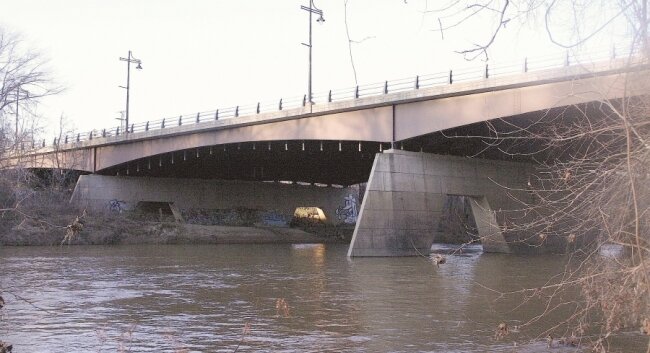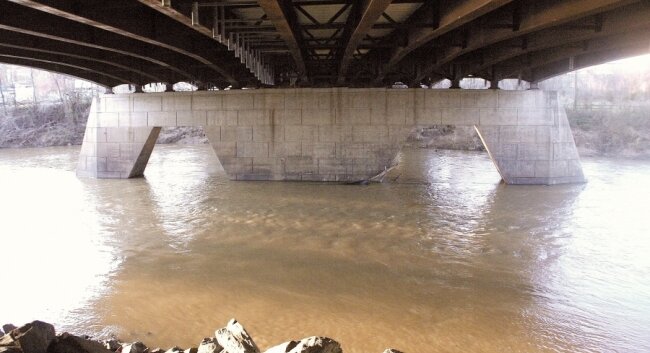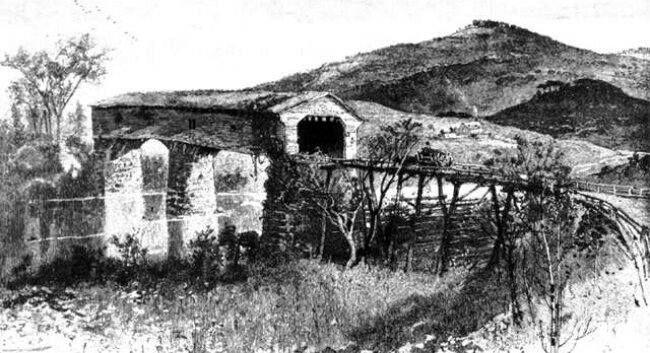Second glance: Free Bridge a design delight
If you live or travel east of Charlottesville, you've probably driven over it hundreds, if not thousands of times without giving it a passing glance. Yet the seven-lane Free Bridge that crosses the Rivanna River on 250 East is an award-winning design project which merits a second glance as officials ponder design ideas for downtown's Belmont Bridge.
"I’ve always thought that Free Bridge is an elegant, simply designed, bridge," blogs local photographer Ed Deasy, who captured a beautiful night shot of the structure. "You do not appreciate this in the least while driving over it. All you see is the railing zipping by. Only from the river can the arched sides be seen."
As Deasy points out, the only way to see those arched sides is to get out of the car and head down to the river. (A reporter can attest that trying to photograph the bridge from the nearby river banks is a challenge, as the trees and thorny brush are thick, and the footing is steep and muddy.)
"We tried to design the bridge to serve as a unique gateway into Charlottesville, not just a standard-issue widened stretch of highway happening to cross a waterway," says Georgia Tech architecture professor Ellen Dunham-Jones, who, with her partner, fellow Tech architect Jude LeBlanc, redesigned the bridge in 1993, changing it from four-lanes to seven to accommodate the increasing traffic over the city's major eastern gateway. At the time, both Dunham-Jones and LeBlanc were at the University of Virginia.
Dunham-Jones says the design duo was also interested in expanding the sidewalks on the bridge, connecting to the then newly-proposed trails along the riverside. The Rivanna Trail is a 2.3-mile paved path that starts at Riverview Park and passes under Free Bridge. On the eastern side of the river, a trail runs all the way to Darden Towe Park. Dunham-Jones says they also hoped to accommodate possible zoning changes that would allow a mix of sustainable residential uses along the riverside.
According to historical documents, the Virginia state legislature approved the construction of a toll bridge over the river in 1762, but it was never built. At the time, travelers crossed by small ferry, on foot, or along Three Notched Road at a site called Secretary's Ford, near the Woolen Mills, when the river was low enough. In the early 1800s, two bridges were built over the river. Later, a wooden covered bridge on stone piers was built (see image), and by 1900 it had been replaced with a structure of iron and concrete.
The state never did manage to collect tolls for crossing the bridge, hence its name.
One disappointment: Dunham-Jones says the fishing platform and the banner poles they designed were not built. Overall, however, she says they have always been pleased with what Charlottesville managed to build.
Indeed, shortly after it was completed, the Free Bridge and the Rivanna River Waterfront Plan received an award for excellence in design from the Virginia Society of the AIA. And so if the Belmont Bridge really needs to be replaced, this might be an ideal example.



5 comments
Thanks Dave for giving us a glimpse into Charlottesville's past and present. I have always thought the zoning along the river, and what one sees lining High Street, is a missed opportunity for the city. Such a mighty river and unless one hits the trail, few opportunities to see it.
Cheers --nice read!
An interesting story might be to compare this design and its costs to the one at JPA and the railroad.
It might be enlightning.
Nice bridge but gee, when you get to it, guess what, you still have to stop. The design should have done away with that ridiculous intersection. Coming down the slope of two hills would of been a perfect place for thru traffic and exit an entrance ramps.
Nice history lesson. But I like it for the way it bounces when you're sitting at the light and a truck drives by...
By the way, the picture caption, "The Free Bridge as seen from its Southwest side," is wrong. It's either _of_ its southwest side (since the bridge runs NW/SE) or _from the southeast_ since you're standing on the east side of the river. Yes?